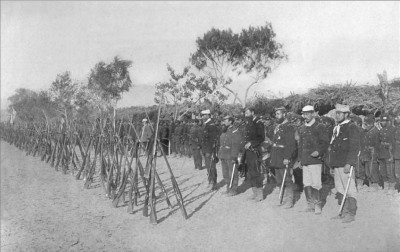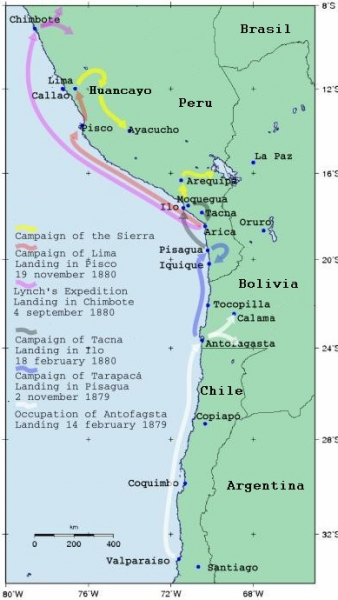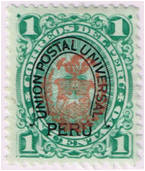ALBUM – view my Chilean occupation of Peru album
Fast Facts
Region: South America
Group: Chilean Occupation of Peru
Classification: Military Occupations
Prior Regime: Republic of Peru
Key Dates:
1879, Feb 14 – Chilean forces occupy the Bolivian port city of Antofagasta.
1879, Apr 5 – Chile declares war on Bolivia and Peru.
1881, Jan 17 – Chilean troops enter Lima
1883, Jul 10 – Peruvian resistance fighter were defeated at the Battle of Humachurco
1883, Oct 20 – Chile and Peru signed the Treaty of Ancón
1884, Aug – Chile removes the last occupying forces from Peru.
Following Regime: Republic of Peru
Scott Catalogue: (Peru, Occupation Stamps) #N11-N23
Pick Catalogue: (Peru) 11-20, S391-304 for Tacna, 1A-7A for Arequipa
Currency: Sol = 100 Centavos 1863-1901, Inca = 10 Soles = 1.000 Reales, 1880-1882
History

The first battles of the war were fought on the sea. At the Battle of Iquique (then in Peru, now in Chile), on 21 May, 1879, the Peruvians suffered the loss of one of their best warships, the Independencia; the Huáscar was captured on 8 October, and this eventual surrender of control of the sea permitted the Chilean army to land on the Peruvian coast.
 On land, the Chilean army bested the badly equipped Bolivian and Peruvian armies, leading to Bolivia’s complete defeat and withdrawal in the Battle of Tacna on 26 May, 1880, and the defeat of the Peruvian army after the Battle of Arica on 7 June, 1880. Chilean forces continued to advance, and on 17 Jan, 1881, Chilean forces captured Lima, the capital city of Peru.
On land, the Chilean army bested the badly equipped Bolivian and Peruvian armies, leading to Bolivia’s complete defeat and withdrawal in the Battle of Tacna on 26 May, 1880, and the defeat of the Peruvian army after the Battle of Arica on 7 June, 1880. Chilean forces continued to advance, and on 17 Jan, 1881, Chilean forces captured Lima, the capital city of Peru.
The national government in Peru was in turmoil. The President of Peru, Nicolás de Pierola escaped Lima, and eventually fled to Europe. While a provisional president was appointed in Lima, Garcia Calderon, he was eventually removed and imprisoned in Santiago and Chile continued the campaign to subjugate Peru. Peruvian resistance arose across the country, encouraged by the U.S., under the leadership of General Andrés Cáceres (the Warlock of the Andes). Initially, the Peruvians were able to inflict damage on Chilean forces, however on 10 July, 1883 at the Battle of Humachurco, Peruvian resistance forces were substantially defeated.
Even though Cáceres tried to regroup, a Peruvian government headed by Miguel Iglesias signed the Treaty of Ancón (October 10, 1883), recognizing defeat and bringing an end to the war. Finally, on 20 October 1883, Peru and Chile signed the Treaty of Ancón. In the treaty, the Peruvian province of Tarapacá would be ceded to the Chile, the provinces of Tacna and Arica would be administered by Chile for 10 years, after which a plebiscite would be held to determine its future sovereignty.
In 1884 a truce between Bolivia and Chile gave the Chile control of the entire Bolivian coast (Antofagasta province), with its nitrate, copper, and other mineral industries; a treaty in 1904 made this arrangement permanent. In return Chile agreed to build a railroad connecting the Bolivian capital of La Paz with the port of Arica and guaranteed freedom of transit for Bolivian commerce through Chilean ports and territory.
After the war, Cáceres refused to recognize Iglesias as president so a civil war broke out between these two factions. Eventually, Cáceres attacked Lima on November 28, 1885, forcing Iglesias to resign on December 12. The country was ruled by a Council of Ministers headed by Antonio Arenas while new elections took place. Running for the Constitutional Party, Cáceres won the elections as sole candidate and assumed as president on June 3, 1886.
For decades thereafter, Chile and Peru failed to agree on the terms of the Tacna and Arica plebiscite. Finally, in 1929, through US mediation under President Herbert Hoover, an accord was reached by which Chile kept Arica. Peru re-acquired Tacna, and ultimately received some concessions on Arica in 1999.
Stamps
 ALBUM
ALBUM
In 1881, after the occupation of Lima, the Chilean controlled government overprinted regular stamp issues of Peru with the arms of Chile, a shield with a white star, surrounded by a wreath below, and topped with three feather plumes (often described erroneously as an eagle).
Simultaneously, the Peruvian government “in exile” were overprinting stamps for use outside Chilean controlled regions. One such overprint was the words “UNION POSTAL UNIVERSAL” in an upside down horseshoe with “PERU” inscribed below the horseshoe. In 1882, these stamps were seized by the Chilean forces, and were overprinted with the Chilean coat of arms for use in occupied areas.
All of the stamps were issued with a grill embossed in the back of the stamp.
During the war, Chilean forces primarily occupied the two largest cities in Peru, Lima & Callao. As these cities were the source of supply of postage stamps, Peruvians in other sections of the country were left without stamps and were forced make provisional issues from whatever material was at hand. Many of these were former canceling devices re-purposed for this. Provisional stamps were issued in: Ancachs, Apurimac, Arequipa, Ayachucho, Chachapoyas, Chala, Chiclayo, Cuzco, Huacho, Moquegua, Paita, Pasco, Pisco, Piura, Puno an Yca. These stamps were also used during the subsequent civil war.
Banknotes
In 1881, occupational banknotes were issued in 1, 5, 100 reales and were overprinted and surcharged “Billete Provisional” and “Republica del Peru” along with the new denomination. Additionally banknotes were issued in denominations of 1, 5, and 100 Incas. In Arequipa, currency was overprinted “Arequipa”.
After the end of the war, provisional banknotes in the occupied province of Tacna were issued in 1886 by Banco de Tacna. (1/2, 1, 2, 5, 10, 50 and 100 sol.)
Links
War in the Pacific by Andrew Clem
War of the Pacific
Chilean Occupation of Peru Overprints





Just a slight historical clarification: “…the Huascar was sunk..”, this is not accurate, in fact the Huascar is still afloat, 135 years later, at Talcahuano Navy Base in the south of Chile.
The Huascar was captured by the Chilean Navy, then the ship served for many years in the Chilean forces until it was restored and it is a floating museum nowadays.
Carlos, thank you for visiting DCStamps, I really appreciate your correction. I will update my entry.
Kind Regards
Michael